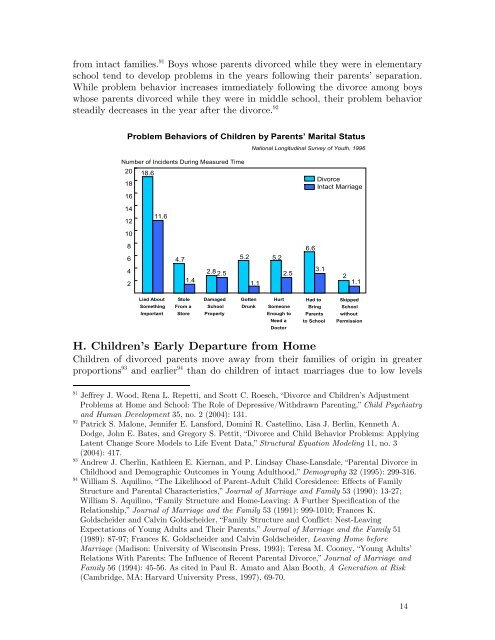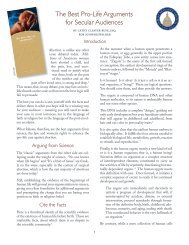The Effects of Divorce on Children - Family Research Council
The Effects of Divorce on Children - Family Research Council
The Effects of Divorce on Children - Family Research Council
You also want an ePaper? Increase the reach of your titles
YUMPU automatically turns print PDFs into web optimized ePapers that Google loves.
from intact families. 91 Boys whose parents divorced while they were in elementary<br />
school tend to develop problems in the years following their parents’ separati<strong>on</strong>.<br />
While problem behavior increases immediately following the divorce am<strong>on</strong>g boys<br />
whose parents divorced while they were in middle school, their problem behavior<br />
steadily decreases in the year after the divorce. 92<br />
Problem Behaviors <str<strong>on</strong>g>of</str<strong>on</strong>g> <strong>Children</strong> by Parents’ Marital Status<br />
Number <str<strong>on</strong>g>of</str<strong>on</strong>g> Incidents During Measured Time<br />
20<br />
18<br />
16<br />
14<br />
12<br />
10<br />
8<br />
6<br />
4<br />
2<br />
18.6<br />
11.6<br />
Lied About<br />
Something<br />
Important<br />
4.7<br />
Stole<br />
1.4<br />
From a<br />
Store<br />
2.8 2.5<br />
Damaged<br />
School<br />
Property<br />
5.2 5.2<br />
1.1<br />
Gotten<br />
Drunk<br />
Nati<strong>on</strong>al L<strong>on</strong>gitudinal Survey <str<strong>on</strong>g>of</str<strong>on</strong>g> Youth, 1996<br />
Hurt<br />
2.5<br />
Some<strong>on</strong>e<br />
Enough to<br />
Need a<br />
Doctor<br />
6.6<br />
<str<strong>on</strong>g>Divorce</str<strong>on</strong>g><br />
Intact Marriage<br />
3.1<br />
Had to<br />
Bring<br />
Parents<br />
to School<br />
2<br />
1.1<br />
Skipped<br />
School<br />
without<br />
Permissi<strong>on</strong><br />
H. <strong>Children</strong>’s Early Departure from Home<br />
<strong>Children</strong> <str<strong>on</strong>g>of</str<strong>on</strong>g> divorced parents move away from their families <str<strong>on</strong>g>of</str<strong>on</strong>g> origin in greater<br />
proporti<strong>on</strong>s 93 and earlier 94 than do children <str<strong>on</strong>g>of</str<strong>on</strong>g> intact marriages due to low levels<br />
91 Jeffrey J. Wood, Rena L. Repetti, and Scott C. Roesch, “<str<strong>on</strong>g>Divorce</str<strong>on</strong>g> and <strong>Children</strong>’s Adjustment<br />
Problems at Home and School: <str<strong>on</strong>g>The</str<strong>on</strong>g> Role <str<strong>on</strong>g>of</str<strong>on</strong>g> Depressive/Withdrawn Parenting,” Child Psychiatry<br />
and Human Development 35, no. 2 (2004): 131.<br />
92 Patrick S. Mal<strong>on</strong>e, Jennifer E. Lansford, Domini R. Castellino, Lisa J. Berlin, Kenneth A.<br />
Dodge, John E. Bates, and Gregory S. Pettit, “<str<strong>on</strong>g>Divorce</str<strong>on</strong>g> and Child Behavior Problems: Applying<br />
Latent Change Score Models to Life Event Data,” Structural Equati<strong>on</strong> Modeling 11, no. 3<br />
(2004): 417.<br />
93 Andrew J. Cherlin, Kathleen E. Kiernan, and P. Lindsay Chase-Lansdale, “Parental <str<strong>on</strong>g>Divorce</str<strong>on</strong>g> in<br />
Childhood and Demographic Outcomes in Young Adulthood,” Demography 32 (1995): 299-316.<br />
94 William S. Aquilino, “<str<strong>on</strong>g>The</str<strong>on</strong>g> Likelihood <str<strong>on</strong>g>of</str<strong>on</strong>g> Parent-Adult Child Coresidence: <str<strong>on</strong>g>Effects</str<strong>on</strong>g> <str<strong>on</strong>g>of</str<strong>on</strong>g> <strong>Family</strong><br />
Structure and Parental Characteristics,” Journal <str<strong>on</strong>g>of</str<strong>on</strong>g> Marriage and <strong>Family</strong> 53 (1990): 13-27;<br />
William S. Aquilino, “<strong>Family</strong> Structure and Home-Leaving: A Further Specificati<strong>on</strong> <str<strong>on</strong>g>of</str<strong>on</strong>g> the<br />
Relati<strong>on</strong>ship,” Journal <str<strong>on</strong>g>of</str<strong>on</strong>g> Marriage and the <strong>Family</strong> 53 (1991): 999-1010; Frances K.<br />
Goldscheider and Calvin Goldscheider, “<strong>Family</strong> Structure and C<strong>on</strong>flict: Nest-Leaving<br />
Expectati<strong>on</strong>s <str<strong>on</strong>g>of</str<strong>on</strong>g> Young Adults and <str<strong>on</strong>g>The</str<strong>on</strong>g>ir Parents,” Journal <str<strong>on</strong>g>of</str<strong>on</strong>g> Marriage and the <strong>Family</strong> 51<br />
(1989): 87-97; Frances K. Goldscheider and Calvin Goldscheider, Leaving Home before<br />
Marriage (Madis<strong>on</strong>: University <str<strong>on</strong>g>of</str<strong>on</strong>g> Wisc<strong>on</strong>sin Press, 1993); Teresa M. Co<strong>on</strong>ey, “Young Adults’<br />
Relati<strong>on</strong>s With Parents: <str<strong>on</strong>g>The</str<strong>on</strong>g> Influence <str<strong>on</strong>g>of</str<strong>on</strong>g> Recent Parental <str<strong>on</strong>g>Divorce</str<strong>on</strong>g>,” Journal <str<strong>on</strong>g>of</str<strong>on</strong>g> Marriage and<br />
<strong>Family</strong> 56 (1994): 45-56. As cited in Paul R. Amato and Alan Booth, A Generati<strong>on</strong> at Risk<br />
(Cambridge, MA: Harvard University Press, 1997), 69-70.<br />
14




